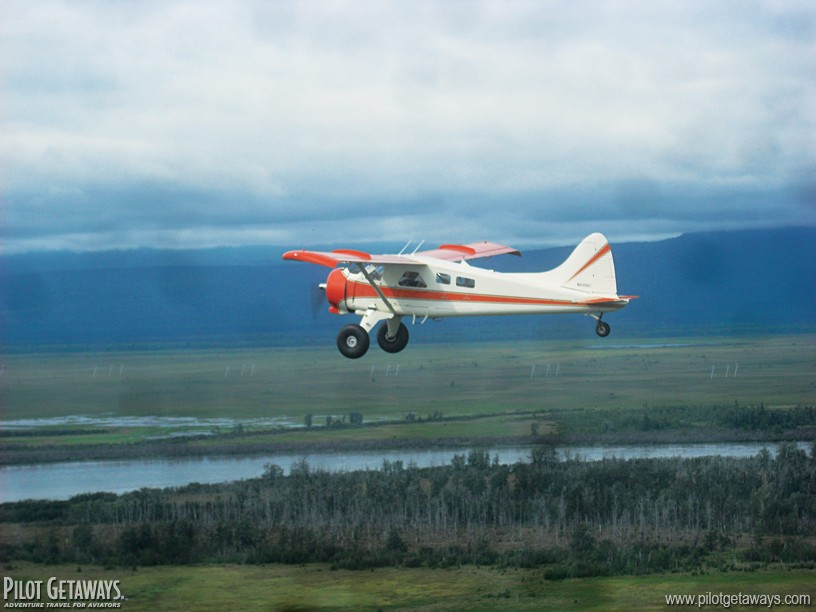You are hereScud Running
Scud Running
If You Must...
by Crista Worthy
There are many ways to kill yourself in an airplane. Alaska has a few all her own. For instance, it’s unlikely you’ll survive a forced landing, only to be eaten by a grizzly, in any other state. So, if you fly to Alaska, bring bear spray. The bear scenario is highly unlikely, but you might actually stand a better chance of meeting a bear than you will of having perfectly clear weather for the duration of your trip in Alaska. Overcast conditions are common during the summer months in Alaska and the Yukon, but if you ground yourself every time the weather is overcast, you might not get anywhere. Experienced Alaska pilots say flying on top and finding a hole to get under is not the answer; you’re better off staying underneath. How can you “scud run” and keep from becoming a statistic?
First let me clarify that I am not talking about flying a couple hundred feet or less above the ground and under a deck in low visibility. That’s suicide. With mountains around, you need thousands of feet of vertical maneuvering room. In controlled airspace, VFR is three miles visibility; in Class G, you legally need only one mile. But in one-mile visibility at 120 mph, your airplane covers the distance you can see in only 30 seconds. Imagine looking down at the chart in your lap or cross-checking instruments. By the time you look up, granite may have emerged from the mist and you can’t avoid it. And have you ever actually flown VFR in truly poor visibility? If not, fly with your instructor on crummy days and find out what one, two, and three-mile visibility really looks like. It may give you pause.
Preflight planning is a must, and get a weather briefing if at all possible. Additionally, the FAA has installed many web-cams throughout Alaska; most are updated every 10 minutes and their locations are shown on VFR Sectionals, avcams.faa.gov. For example, a flight from Anchorage to Port Alsworth means you fly west through Lake Clark Pass, which frequently gets socked in by clouds. FAA webcams in this pass face both east and west and you can view them online before departure. There is no guarantee the weather won’t change while en route, so the FAA also has a webcam website for mobile devices, avcams.faa.gov/m.
It’s certainly not illegal to fly VFR under an overcast if you maintain proper cloud clearance for the airspace you’re in. Local Alaska pilots do it all the time, but they have one huge advantage you don’t: they know the terrain (even so, aircraft accident statistics in Alaska are worse than in the lower 48). If you’re getting ready for a flight, ask local pilots about special considerations along your route. Locals usually know weather patterns in their area and can give you important advice. Make sure you carry enough fuel so you don’t run dry if you have to turn back. Before departure, research locations with fuel along your route.
When you fly under the clouds, situa- tional awareness is critical at all times. You must always know exactly where you are. If you fly to Alaska (or any other faraway des- tination), make sure you have all the VFR charts you may need before you depart. Even if local FBOs stock the charts, they may have sold out. Before each flight, thor- oughly study the charts you expect to use. Mark your path and note landmarks, elevations, and escape routes should you encounter adverse weather. For me, a GPS with moving map, terrain, and weather is mandatory. On your flight, track your progress with everything you have: your charts, GPS, and VOR if possible, so you can always confirm where you are. But keep your eyeballs looking outside too. If you ever become uncertain about your position, turn back to a known location and get it figured out. Otherwise you may fly up a box canyon without knowing it.
It’s much easier to get lost, disoriented, or fail to recognize landmarks (crucial to pilotage) at a lower altitude. I recall many years ago, after having come down through the clouds and then leveling at not much above pattern altitude in excellent visibility, I could not spot Dallas Love Field until we were almost on top of it.
You always want to have an escape route in case the weather ahead takes a sudden turn for the worse. Often the escape is behind you, but there may be drainages on either side that offer better weather. If you are flying in a pass or canyon and the mountain tops above you are obscured, make sure the pass or canyon is plenty wide enough to turn around. Fly on the downwind side of the canyon and slow down, which greatly reduces your turn radius. It also gives you more time to react.
Never fly toward reduced visibility without knowing what’s on the other side. Recently I rode in the back of a Cessna from Oregon to Idaho. Clouds obscured the mountaintops on both sides of Hells Canyon, but I wasn’t too concerned, as the two pilots in front had at least 80 years of local experience between them. As we proceeded south through the canyon, it grew quite murky ahead and the rain began to increase. I sat up, looked ahead, and wondered whether I would proceed if I were flying alone. I decided I would, as I knew the canyon opened up to flat land ahead, there was more than enough space to easily turn around if visibility dropped too much, and we had thousands of vertical feet of clear air (Hells Canyon is deeper than the Grand Canyon). But in an unfamiliar Alaskan pass? It would be time to go back, or hire a charter pilot who’s been around a long, long time.



Wonderful / wise advise Crista... Always thoroughly enjoy your articles......
Richard Bend, Ore